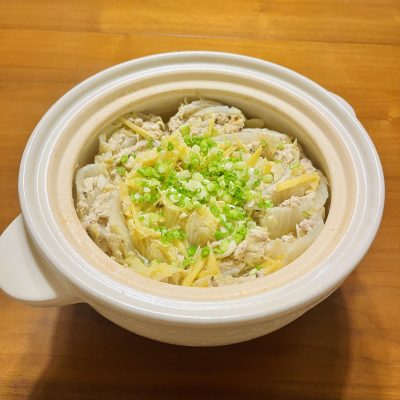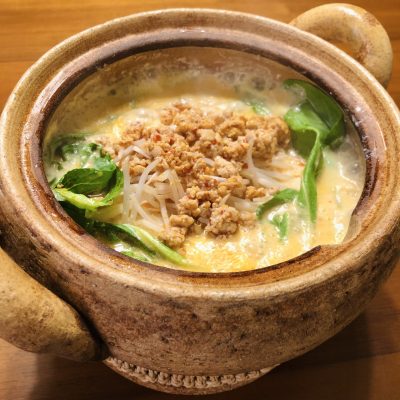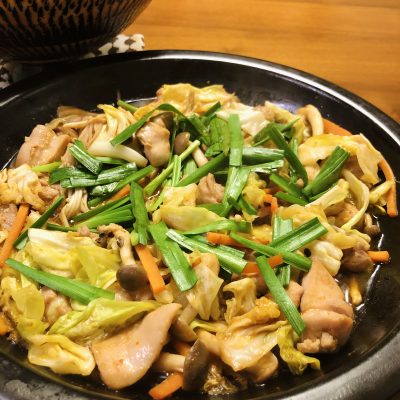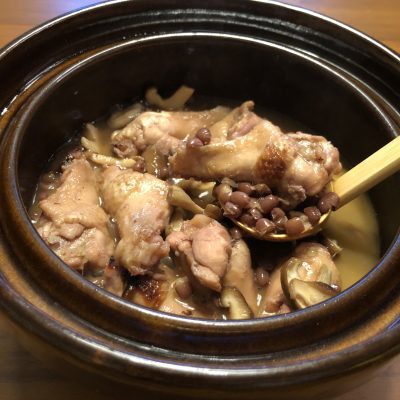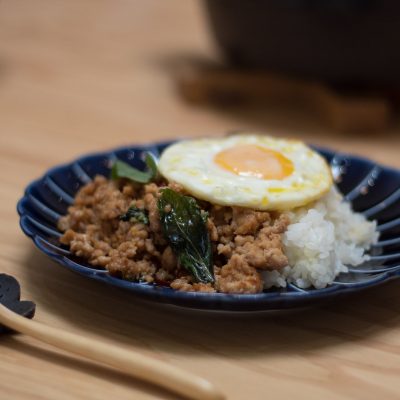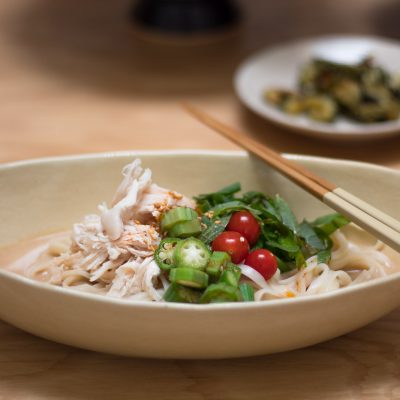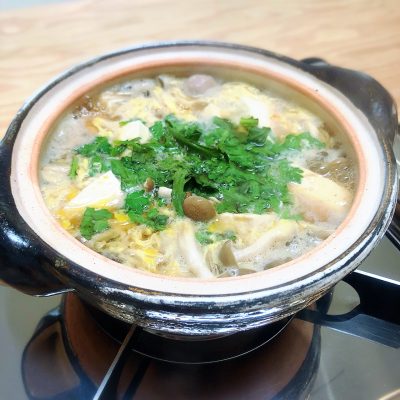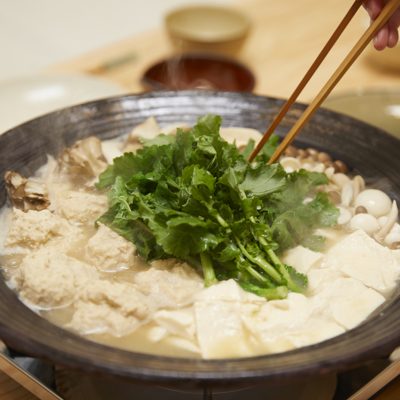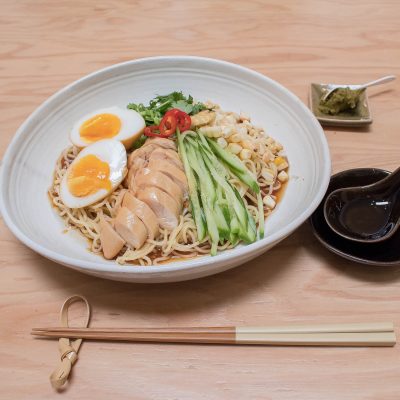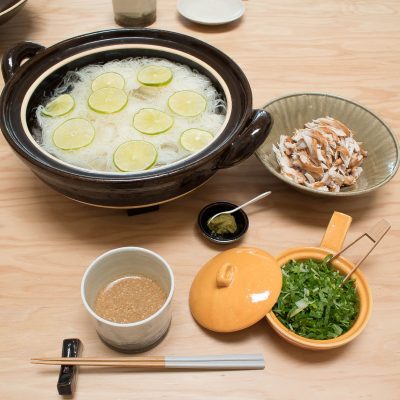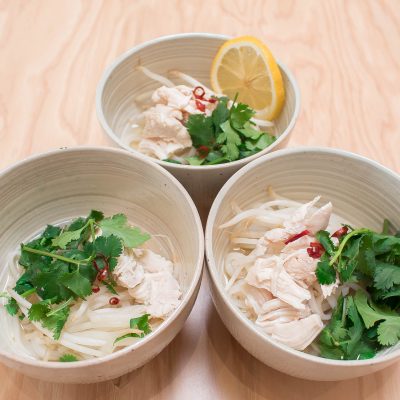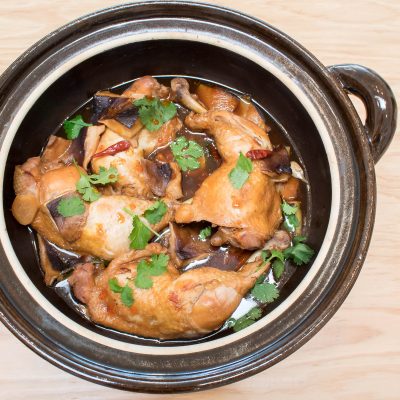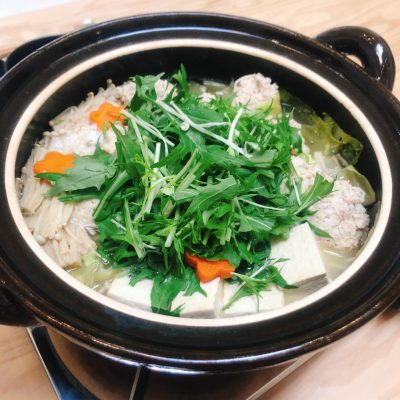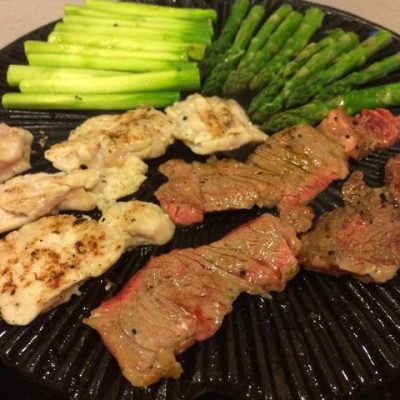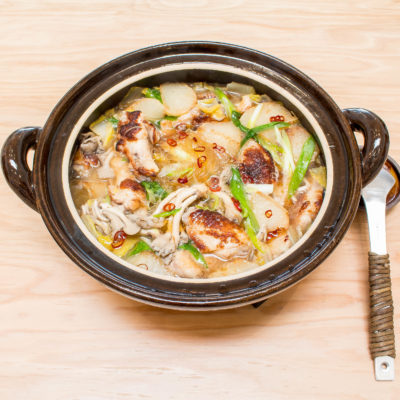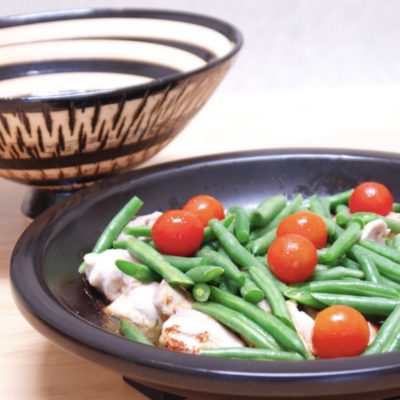Here is a new variation to my “mille feuille” nabe recipes and this is a total keeper. It’s napa cabbage with ground chicken and tofu filling and tastes so rich and soothing. I season the dish with a Vegetable Dashi bag by simply tearing the bag and sprinkle the contents over the dish before cooking. This vegetable dashi bag is so convenient and the result is simply fantastic. The dish is packed with umami and already so tasty on its own, but I like to drizzle a small amount of soy sauce or a dab of Yuzu-Kosho.
Tag Archives: Chicken
Sesame and Saikyo Miso Hot Pot with Chicken Meatballs
This is an especially comforting donabe hot pot dish. Saikyo miso is a (naturally) sweet white miso, and the dashi based broth is flavored with sesame paste and Saikyo miso. Ginger-rich chicken tsukune (meatballs) are really fluffy and also adds depth to the broth. They are cooked along with different vegetables and just so satisfying. This is like a Japanese version of “chicken soup” to nourish your body and soul.
Soymilk Tan Tan Nabe
Tan Tan Nabe, or Chinese-inspired miso-sesame broth with ground meat donabe hot pot is one of the most popular dishes from my DONABE Cookbook. Here is another variation of Tan Tan Nabe and it’s Soymilk Tan Tan Nabe. The soymilk adds the extra richness to the flavor of this dish, while the dish is quite healthy. The broth is so flavorful and soothing with a spicy kick. Also, it’s so easy to make. So, I love making this dish so much.
Sizzling Shoyu Chicken & Cabbage
Kei-chan is a very popular local dish from Gifu, Japan. In my past visits to Gifu, I was really fascinated by this homy chicken dish. The main ingredients are chicken and cabbage, and they are sit-fried together in either miso or soy-based sauce. I especially love the soy-based version, so I now have my own version and it’s so good. Because it’s stir-fried, tagine-style donabe works especially great with its flat skillet bottom. But, you can also improvise the dish with other types of donabe which can be heated empty.
Azuki Chicken
I grew up eating Azuki (or adzuki) beans and love them in both sweet and savory dishes. They cook fast and very versatile. Here is my Azuki Chicken – extremely simple stew of these two main ingredients. This humble dish is so tasty and always warms my heart. When it’s cooked in donabe, the ingredients come out so tender and flavors become so deep. While any donabe with enough capacity can cook this dish wonderfully, I especially love using my Roast Donabe. This cute compact donabe has an extra thick body with a sturdy flat lid (with no vent) that helps create optimum insulation and moisture retention. And, as the name suggests, this donabe is great for roasting as this can be heated with no liquid inside.
Thai-Style Basil Chiken Over Rice
This dish is my homage to a popular Thai dish, pad gaprao (“holy basil chicken rice”; this dish is also popular in Japan, and we call it gapao gohan), and every component (chicken, rice, and egg) is made in a different style of donabe. This simple dish is so easy to make and really satisfying, so I make it quite often.
For the basil chicken, you can make it with any classic-style donabe, but I especially recommend Bistro Donabe. It’s because this donabe can be heated when it’s empty, so you can sauté the chicken more effectively with the intense heat. The sturdy flat lid of Bistro Donabe can also give a nice pressure during simmering. The main seasonings are oyster sauce and Ayu Fish Sauce, they bring really nice layers of umami flavors. While most Asian fish sauce (such as nan pla) has distinctive salty flavor, Ayu fish sauce is much more round and richer in umami. You can still use regular Asian fish sauce, but in that case, I suggest you use less amount of it.
For the fried egg, you can use a regular pan, but my choice of equipment is always Donabe Egg Baker. It’s so handy and you can make an individual serving (up to two eggs) fried eggs in a short time.
Cold Udon with Sesame Soymilk Sauce
This cold udon dish has a very tasty and refreshing broth made of soymilk and golden sesame paste. It’s poured over the udon and really makes the dish so special. For this broth, I use my Dashi Shoyu (rich dashi-flavored soy sauce) as a base seasoning. This Dashi Shoyu is extremely versatile and can be used it on its own as a seasoning for sautéed dish or can be mixed other liquid (can be just water) to make a broth or a sauce. So, I keep my Dashi Shoyu in my fridge always. Once you make a batch of it, you can keep it for up to a month or even longer.
The toppings can be basically anything you like, so you can be creative.
Simmered Egg-Drop Chicken & Asparagus with Sansho Berries
This dish is a variation of Chicken & Tofu Hot Pot with Egg dish, and this dish is less soupy and the broth plays a role more as a seasoning for the ingredients. The combination of chicken, egg, and asparagus almost never go wrong, especially when asparagus is in high season in the spring time. The dish is topped with Salt-Pickled Sansho Berries, which bring such beautiful accent to the dish, but if you don’t have them, you can sprinkle some Sansho Powder, and it’s also very good for this dish.
Classic Chicken and Root Vegetable Stew
This is a traditional stew called Chikzen-ni, and is often served in a Japanese New Year meal, and one of my favorite New Year dishes since I was a child. The root vegetables such as burdock, lotus, carrot and sato-imo (taro) are cooked with konnyaku (yam jelly), dry shiitake, and chicken in dashi, and seasoned with soy sauce and black sugar. The flavor is so rich and you can really enjoy the nice earthy flavors.
When I serve this dish in the New Year, I cut the lotus and carrot into decorative shapes, but for any regular occasion, that’s not necessary.
Although I love the flavor of the chicken in Chikuzen-ni, this dish can easily be converted into a vegan dish by simply omit the chicken and use vegan dashi (i.e. kombu and dry shiitake dashi). You can also make it gluten-free by substituting the soy sauce and white tamari with tamari soy sauce.
Shiso Chicken Meatball & Grated Daikon Hot Pot
This dish is packed with nutrients, and so easy to make. It’s also a great dish to enjoy with guests. Chicken meatballs have the very nice subtle shiso flavor and they become fluffy after cooked. I like adding a generous amount of coarsely grated daikon (I highly recommend you use Onioroshi daikon grater for the nice crunchy texture for grating daikon). They give both texture and more flavor to the dish.
For seasoning, I use both white tamari and soy sauce for more complex flavor (and also to keep the broth from becoming too dark), but you can use just soy sauce if you like. You can also adjust the seasoning with extra sea salt at the end. But, please remember, this dish is served with Sansho Ponzu Sauce, so the seasoning should be minimum.
Make sure to save enough broth, so you can enjoy the shime (finishing course) of soba noodles!
Chicken & Tofu Hot Pot with Egg
This is my lazy-day but feel-good quick hot pot dish. I love my small size donabe so much, as it’s so handy to use, and I can make quick one-pot-meal for 1 to 2 people in a short time. In this dish, dashi (stock) is heated with soy sauce and mirin, then chicken, tofu, and mushrooms are added one after another to cook in the broth. Once everything is cooked through, eggs are drizzled in and cooked further (I like the soft stage). I used shungiku (chrysanthemum leaves) as a topping, but you can simply use thinly-sliced green onion or any of your choice of green topping. Enjoy with some sansho powder.
Chicken Meatball Hot Pot in Miso Broth
This simple miso-flavored hot pot is always so popular among my family and friends. By adding grated ginger and egg, the chicken meatballs becomes so fluffy and flavorful. The other main ingredients are tofu and mushrooms, which complete the dish to full satisfaction. The suggested shime (finishing course) to cook in the saved broth is udon or ramen.
Smoked Chinese-style Cold Noodle
Smoked toppings give such a tasty and unique upgrade to the popular summer dish. This dish has not only been a summer hit at my home, but I actually like to make it whenever I want all year round. The yuzu-flavored broth is so refreshing and creates a nice balance with the smoked toppings. For me, Yuzu-Kosho is an essential addition to add a nice kick to this dish, but it’s totally optional for those who prefer a less spicy flavor.
Cold Somen Noodle with Golden Sesame Dipping Sauce
During the hot summer season in LA or Tokyo, ice-cold somen noodle is often the only thing I feel like having, and I never get tired of it. Did you know donabe is a perfect vessel for serving cold dish, too? With the porous clay body, donabe can keep the cold food very cold for a extended period of time. Also, it simply looks pretty to serve anything out of donabe, too! For this dish, I introduce my golden sesame dipping sauce. It’s rich in flavor yet refreshing. As for the toppings/ condiments, you can make it as simple like just sliced scallion and Shichimi Togarashi, or you can create a wide array of different toppings when you serve this dish to your guests. In this recipe, I serve with smoked chicken tender, mixed herbs and Yuzu-Kosho.
Make Your Own Steamed Chicken Pho
Inspired by a popular Vietnamese noodle dish, this is my Japanese version of it and the dish totally takes advantage of the unique versatility of the donabe steamer, Mushi Nabe. I can do steaming and simmering in one pot, and it makes a great presentation at the table, too. I also love serving it hot pot style, so you can cook a small batch of noodles to serve at a time and continue to cook and serve until done. Then, you can choose and enjoy different toppings for every batch, if you like. You can be creative and serve with a wider variety of toppings, too. The broth has layers of umami flavors with the dashi, reserved chicken juice and Ayu fish sauce. This dish is always so comforting and fun at the same time. Instead of serving with a sliced lemon, you can also try with a splash of Pure Hon-Daidai Citrus Juice. The bright aroma of the daidai citrus will completely upgrade the dish to another level!
Chicken, Kabocha & Mochi Mugi Stew in Shio-Koji Broth
This hearty stew is so nourishing and tasty. The only seasoning is basically Liquid Shio-Koji, and this magical seasoning makes the chicken extra tender. With the addition of kabocha and Mochi Mugi barley, this dish tastes so complete and makes an ideal one pot meal. My body always feels so great after eating a big bowl of this stew. For this dish, I like making dashi (soup stock) with kombu and dried shiitake by soaking them in water for a few hours (to over night) in advance. They not only make the soup taste wonderful but also they can be sliced and added to cook in the stew to enjoy. But, you can also make this dish with chicken stock or vegetable stock and it will be delicious, too.
Braised Chicken in Black Vinegar Sauce
The main ingredients of this dish are just chicken and shiitake mushrooms, yet this dish can make such a hearty meal. The meat is so succulent and falls off the bone easily even with chopsticks. The special black vinegar from Kyoto gives the umami-packed layer of flavors to this easy one-pot dish.
Salt Butter Chanko Hot Pot
Japanese sumo wrestlers cook and eat chanko nabe at their stable every day. That’s the source of their strength. While chanko nabe refers to any types of hot pot eaten by sumo wrestlers, the most typical style is chicken as a main protein and cooked in chicken broth. It’s because chicken stands on two legs like human beings, so it is considered to bring good luck (in sumo, you lose if your hands touch the ground). Chanko nabe typically makes a very nutritious and balanced meal, as you cook a wide variety of healthy ingredients in one pot. The sumo wrestlers are big, because they eat so much of it every meal! In my version, I cook chicken meatballs and vegetables in simple salt-flavored chicken broth, and add butter cubes right before serving. The aroma is so irresistible and the flavor is superb. As a shime (finishing course), I suggest ramen noodles to cook in the remaining broth.
Make Your Own Shoyu Ramen Hot Pot
Making ramen is easy and fun, especially if you cook and serve as donabe hot pot right at the table. I like adding the chopped nira (garlic chives) to the ramen right before serving, but if you can’t find nira, you can substitute with thinly-sliced green onion and serve as a topping, instead. Enjoy with a couple of simple toppings or a make a platter of a wide selection of toppings to choose from for fun.
Soy-Flavored Simmered Ground Chicken
Very popular among Japanese people of all ages, this juicy simmered ground chicken is cooked in simple seasonings of soy sauce, sake, mirin, and sugar, and is typically served over plain rice. When I was a teenager, this dish, tori soboro gohan, used to be one of my favorite items in the bento my mom made me to take to school for lunch. My version has the accent of a generous amount of shredded ginger to stimulate your appetite. I like to serve it with a very soft-boiled egg (with runny egg yolk) over freshly cooked donabe rice. You can also enjoy it as a topping for steamed kabocha, asparagus, or tofu.
Beef Rib-eye and Shio-koji Chicken Tender Yakiniku
Our standard yakiniku menu we never get tired of!
Chicken Wings & Daikon Hot Pot
Chicken wings and daikon are a classic combination in Japanese cooking. By pan-frying these ingredients before adding to the broth, the flavor of this simple dish enhances dramatically. Because the chicken is already marinated in shio-koji, this dish doesn’t require much more seasoning. Feel free to use fingers to savor the wings, as it’s part of the fun of this dish!
Nao Man Gai (Chicken Over Rice)
This dish is inspired by kao man ghai, a very popular Thai-style chicken rice dish, (or the Singapore-style is known as Hainanese chicken rice), and I made it in my donabe Japanese version with mostly Japanese ingredients. So, I call it Nao Man Gai! The rice is cooked with rich Japanese chicken stock with chicken on top, so the rice tastes really special even on its own. The chicken is sliced and served on top of the rice along with two kinds of special sauces. Don’t forget to make non-boiled “boiled eggs” by placing eggs on the inner lid of Kamado-san when cooking the rice. The eggs are ready when the rice is ready, and they taste so good with the dish!
Steam-fry Shio-Koji Chicken, Green Beans, and Cherry Tomatoes
Chicken is quickly sautéed first, then steam-fried together with vegetables in Fukkura-san. Shio-koji marinated chicken has extra rich flavor with succulent texture. Drizzle some soy sauce and squeeze a generous amount of lemon as soon as the heat is turned off and the donabe is brought to the table, so they will sizzle with the residual heat in the skillet and becomes so aromatic.

